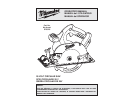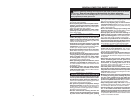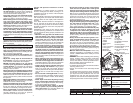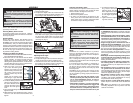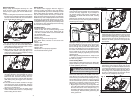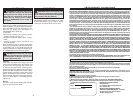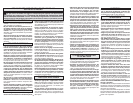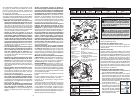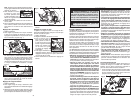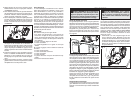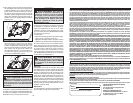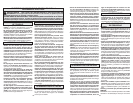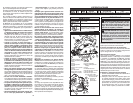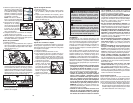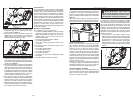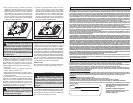
8
9
General Operation
Always clamp the workpiece securely on a saw
horse or bench. See “APPLICATIONS” for the
correct way to support your work in different situ-
ations.
1. Draw a cutting line. Place the front of the shoe on
the edge of the workpiece without making blade
contact. Hold the handle with one hand and the
front handle with the other (Fig. 4).
Electric Brake
The electric brake engages when the trigger is
released, causing the blade to stop and allowing
you to proceed with your work. Generally, the saw
blade stops within two seconds. However, there
may be a delay between the time you release the
trigger and when the brake engages. Occasionally
the brake may miss completely. If the brake misses
frequently, the saw needs servicing by an autho-
rized MILWAUKEE service facility. The brake is not
a substitute for the guard, and you must always wait
for the blade to stop completely before removing
the saw from the workpiece.
Troubleshooting
If the blade does not follow a straight line:
• Teeth are dull. This is caused by hitting a hard
object such as a nail or stone, dulling teeth on
one side. The blade tends to cut to the side with
the sharpest teeth.
• Shoe is out of line or bent
• Blade is bent
• Rip fence or guide is not being used
If the blade binds, smokes or turns blue from
friction:
• Blade is dull
• Blade is on backwards
• Blade is bent
• Blade is dirty
• Workpiece is not properly supported
• Incorrect blade is being used
2. Line up the sight line with your cutting line. Posi-
tion your arms and body to resist KICKBACK.
3. To start the saw, push the lock-off button down
while pulling the trigger. Allow the motor to reach
full speed before beginning cut.
4. While cutting, keep the shoe fl at against the
workpiece and maintain a fi rm grip (Fig. 5). Do
not force the saw through the workpiece. Forcing
a saw can cause KICKBACK.
Fig. 5
Fig. 4
5. If making a partial cut, restarting in mid-cut or
correcting direction, allow the blade to come to
a complete stop. To resume cutting, center the
blade in the kerf, back the saw away from cut-
ting edge a few inches, push the lock-off button
down while pulling the trigger and re-enter the
cut slowly.
6. If the saw binds and stalls, maintain a fi rm grip
and release the trigger immediately. Hold the
saw motionless in the workpiece until the blade
comes to a complete stop.
7. After fi nishing a cut, be sure the lower guard
closes and the blade comes to a complete stop
before setting the saw down.
Cutting Large Panels
Large panels and long boards sag or bend if they
are not correctly supported. If you attempt to
cut without leveling and properly supporting the
workpiece, the blade will tend to bind, causing
KICKBACK.
Support large panels. Be sure to set the depth of
the cut so that you only cut through the workpiece,
not through the supports.
APPLICATIONS
Ripping Wood
Ripping is cutting lengthwise with the grain. Select
the proper blade for your job. Use a rip fence for
rips 4" wide or less. To install the rip fence, slide
the bar through the rip fence slot in either side of
the shoe. The width of the cut is the distance from
the inside of the blade to the inside edge of the rip
fence. Adjust the rip fence for the desired width,
and lock the setting by tightening the rip fence
adjusting knob.
When ripping widths greater than 4", clamp or tack
1" lumber to workpiece and use the inside edge of
the shoe as a guide.
Cross-Cutting Wood
Cross-cutting is cutting across the grain. Select the
proper blade for your job. Advance the saw slowly
to avoid splintering the wood.
WARNING To reduce the risk of elec-
tric shock, check work area for hidden
pipes and wires before making pocket cuts.
2. To start the saw, push the lock-off button down
while pulling the trigger. Allow the motor to reach
full speed before beginning cut. Using the front
of the shoe as a hinge point, gradually lower the
back end of the saw into the workpiece (Fig. 8).
Release the lower guard lever and grasp the
front handle.
3. When the shoe rests fl at against workpiece,
advance the saw to the far corner (Fig. 9). Re-
lease the trigger and allow the blade to come to
a complete stop before removing it from work-
piece. Repeat the above steps for each side of
the opening. Use a Sawzall
®
reciprocating saw,
jig saw or small hand saw to fi nish the corners
if they are not completely cut through.
Pocket Cutting
Pocket cuts are made in the middle of the work-
piece when it can not be cut from an edge. We rec-
ommend using a Sawzall
®
reciprocating saw or jig
saw for this type of cut. However, if you must use a
circular saw to make a pocket cut, USE EXTREME
CAUTION. To maintain control of the saw during
pocket cutting, keep both hands on the saw.
1. Beginning at a corner, line up the sight line with
your cutting line. Tilt the saw forward, fi rmly fi xing
the front of the shoe on the workpiece (Fig. 7).
The blade should be just above cutting line, but
not touching it. Raise the lower guard using the
lower guard lever.
Fig. 6
Fig. 7
Fig. 8
Fig. 9



